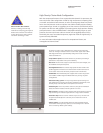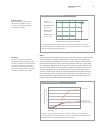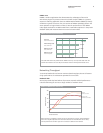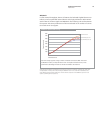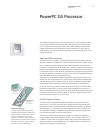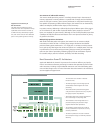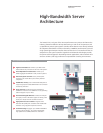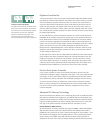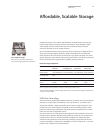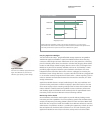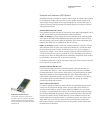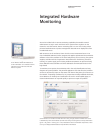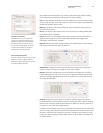
Gigahertz Frontside Bus
To harness the power of the G5 processor, a 64-bit Double Data Rate (DDR) frontside
bus speeds up communication between the PowerPC G5 and the memory controller.
Unlike conventional processor interfaces, which carry data in only one direction at
a time, this dual-channel frontside bus has two 32-bit point-to-point links: One link
travels into the processor and another travels from the processor, which means no
wait time while the processor and the system controller negotiate which will use the
bus or while the bus switches direction. This elastic interface self-tunes during startup
for optimal signal quality.
On the 2GHz PowerPC G5, the frontside bus operates at 1GHz for a total theoretical
bandwidth of up to 8GB/s. Dual processor systems get an even greater performance
boost, because each PowerPC G5 has a dedicated frontside bus. This unique feature
results in a maximum aggregate raw bandwidth of 16GB/s on dual 2GHz Xserve G5
systems. This is well over twice the 6.4GB/s maximum throughput of Itanium 2–based
systems and almost four times the 4.3GB/s throughput of Xeon-based systems.
Because there’s a dedicated data path in each direction, transaction-intensive server
operations execute fast and without contention for data—so the processor doesn’t
sit idle, waiting for data to arrive.
On dual processor systems, the two independent frontside buses allow each PowerPC
G5 to handle its own tasks at maximum speed with minimal interruption. They also
enable each processor to discover and access data in the other processor’s caches,
a technique called intervention, or snooping. Cache intervention guarantees cache
coherency, which ensures that the processor always fetches the correct data, even if
the data has been modified and is stored in the cache of the other processor.
Point-to-Point System Controller
A new system controller is central to the overall performance of Xserve G5. This
revolutionary application-specific integrated circuit (ASIC)—built using advanced IBM
technology—is one of the industry’s fastest. A superefficient point-to-point architec-
ture provides each primary subsystem with dedicated throughput to main memory,
so massive amounts of data can traverse the system without contention for band-
width. In contrast, subsystems on Xeon-based servers must share bandwidth, which
can result in time-consuming arbitration while they negotiate for access across a
common data path.
Advanced ECC Memory Technology
Xserve G5 maximizes the efficiency of its computing power with an advanced 128-bit
DDR memory architecture and support for up to 8GB of RAM. This high-speed, high-
capacity memory architecture enables video encoding, transaction-intensive network-
ing, and scientific applications to perform radically faster. What’s more, it works with
ECC logic in the system controller to protect data from corruption or errors.
Double Data Rate (DDR) memory
Xserve G5 features a memory controller that supports 400MHz, 128-bit DDR SDRAM.
With fast DDR memory and a wider 128-bit interface that addresses two banks of
SDRAM at a time, Xserve G5 can reach a memory throughput of up to 6.4GB/s—more
than double the throughput of the G4-based Xserve. For even greater performance,
direct memory access (DMA) works with the point-to-point system controller, so
subsystems can access main memory without needing to interact with the processor.
14
Technology Overview
Xserve G5
Industry’s fastest frontside bus
The dual-channel frontside bus allows data to
travel to and from the PowerPC G5 processor
at the same time. On dual processor systems,
each PowerPC G5 has its own dedicated
interface to maximize throughput—com-
pared with dual Xeon-based systems, in
which the processors must share a single bus.
PowerPC G5 PowerPC G5
Xeon Xeon



